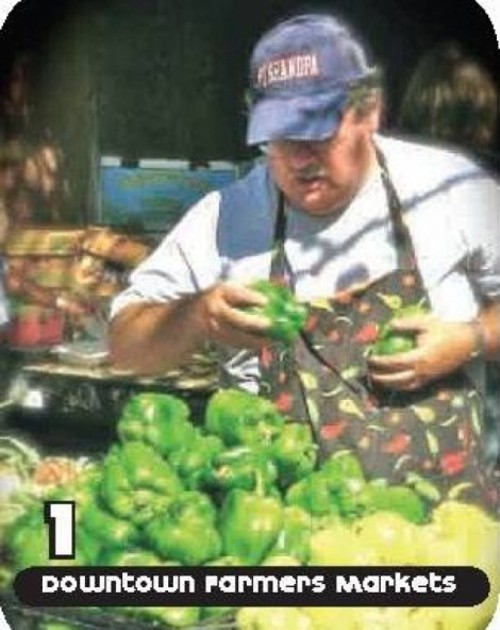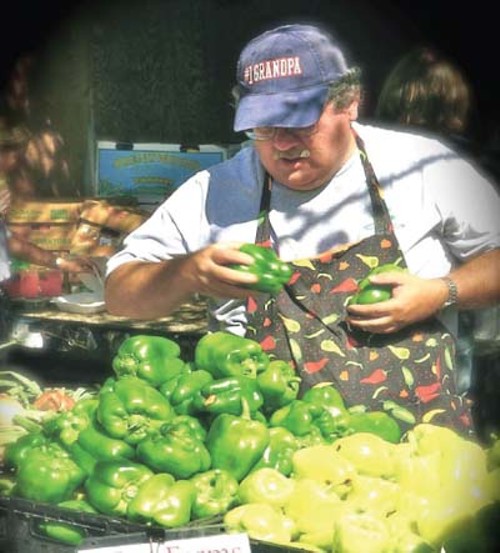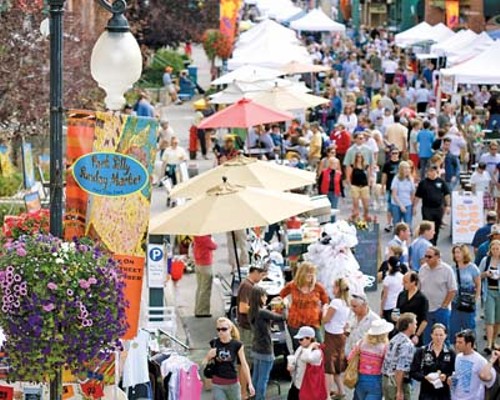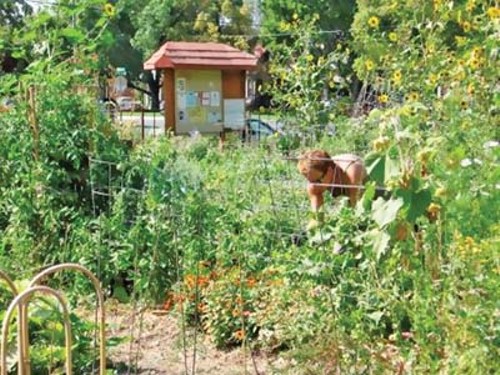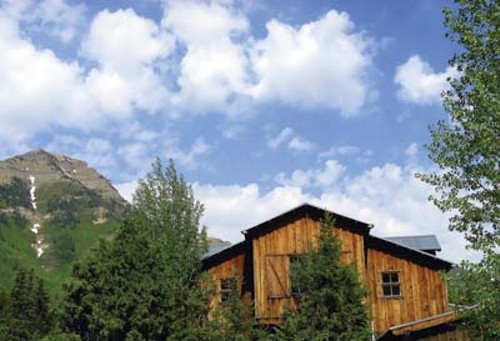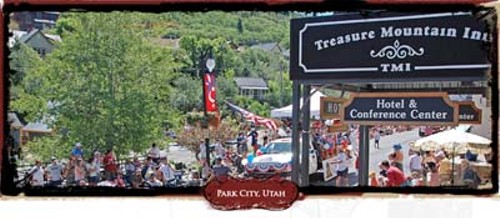The Green 25
Green Issue: ‘Ecopreneur’ Scott Cooney gives props to local green pioneers and innovators.
By Scott CooneyAs the co-founder and former publisher of a green business directory for the greater Salt Lake area, I am grateful that green has gained so much public interest in recent years and hope that the trend continues. The following Top 25 green things in the Salt Lake City area is a very subjective and totally personal list. As a lifetime student of sustainability, I compiled and ranked the list according to the principles of sustainability: community building, progressive seventh-generation thinking, social responsibility, civic participation, the three R’s (reduce, reuse, recycle), and just as importantly, things that make sustainability fun (which in turn makes it something people want to do), such as the incredible organic fare at Sage’s Café, the super fun eco-transportation at Eco-Moto where I bought my Phantom scooter, and the beautiful, green-built downtown library, where I wrote the grand majority of the text for my book (Build a Green Small Business, McGraw-Hill). We are truly blessed to have so many great, green resources at our fingertips. Supporting them and enjoying them will help to create the kind of community we all hope to live in … peaceful, prosperous, sustainable, livable, equitable, and enjoyable.
1. Local farmers markets. Bill McKibben, in Deep Economy, details how we can build local living economies, get healthy food to the masses, fight sickness and disease, and keep more of our money away from the agribusiness giants … and the answer starts with farmers markets. Salt Lake’s Downtown Farmers Market is a spectacle to behold and a terrific way to spend a Saturday morning. Park City’s Park Silly Sunday Market has gone zero-waste (only seven and a half bags of trash sent to the landfill in 2008), to boot, with everything going to recycling or composting. Both sport organic produce, artisan breads, local cheeses, handicrafts, eco-friendly goods, a variety of Community Supported Agriculture (CSA) projects, and, as McKibben notes about farmer’s markets as compared to shopping at a traditional grocery store: “One-tenth the energy [consumed from fossil-fuel sources]; 10 times the [community-building] conversations.” DowntownSLC.org, ParkSillySundayMarket.com
2. Søren Simonsen, Salt Lake City Councilman. Who better to help with city planning for a sustainable Salt Lake City than a green architect? Simonsen is laying the groundwork now to provide the framework for a walkable, bike-friendly, sustainable Salt Lake City full of energy-efficient buildings, cool neighborhoods, and locally owned businesses. Since it may be that U.S. Rep. Jim Matheson, D-Utah, is not progressive enough to represent our blue island, maybe we should start printing the bumper stickers: S%uFFFDren for Congress in 2010!
3. Vegetarian-friendly Salt Lake. Switching to a vegetarian diet can reduce your ecological footprint more than switching from a gas-guzzler to a hybrid Prius. Vegetarianism’s reduced environmental footprint is showcased au extraordinaire in several Salt Lake City establishments (see No. 10), but overall, Salt Lake City took No. 3 on GoVeg.com’s ranking of vegetarian-friendly small U.S. cities. Salt Lake City was dubbed a “vegan’s paradise” by GoVeg. They recommend the vegan cheese pizza at Este in Sugar House and downtown and the organic basil macadamia pesto pasta at Sage’s Café.
4. Wasatch Community Gardens. WCG is a community-based nonprofit established in 1989 that empowers people of all ages and incomes to grow and eat healthy, sustainable food. With a plant sale featuring heirloom, organic and drought-resistant plants (May 9 at Rowland Hall on Guardsman—stop by before or after Live Green!, No. 17 below), and workshops on composting, organic gardening (en Español, tambien!), container gardening, fruit-tree pruning, solar cooking, urban chicken-rearing, and starting a school garden, WCG is helping Salt Lake City build community, grow local food organically, and educating thousands of people (especially kids!) to do the same. Salt Lake City garden locations include: Grateful Tomato Garden, 800 S. 600 East; Fairpark Garden, 1037 W. 300 North; and Fourth East Garden, 553 S. 400 East. In Sandy, Historic Sandy Garden, 8400 S. 115 East. WasatchGardens.org
5. Caffe Ibis. Artisan roaster in Logan produces seriously sustainable coffee that is organic, Fair Trade, and shade grown, meaning it creates community, preserves rainforest and eliminates poverty. And, it’s really freaking good. Served at The Coffee Garden, among other places! CaffeIbis.com
6. TreeUtah. With 300,000 trees planted since 1990, it would be hard to argue that anyone is making a bigger difference for clean air and carbon sequestration in the state of Utah. TreeUtah also maintains the educational EcoGarden at the Day- Riverside Library (No. 14). 740 S. 300 West, Suite 301, 801- 364-2122. TreeUtah.org
7. The Green Building Center. The appropriately named retail outlet continues to provide goods and services to help citizens and businesses build and remodel green. Recently, Planned Parenthood of Orem worked with the Green Building Center to install bamboo floors, use American Clay products as well as recycled tiles and eco-friendly countertops from the Green Building Center. It will be the first LEED-certified building in Orem, as well as the first LEED-certified Planned Parenthood in the country. The Green Building Center is worth a visit as an example of one of the coolest green retail outlets out there. 1952 E. 2700 South, Salt Lake City, 801-484- 6278; 1105 Iron Horse Drive, Park City, 435-649-8262. GreenBuildingCenter.net
8. Utah representing red states in green initiatives. No, really! California has led an effort, signed on to by 16 other states, to measure CO 2 emissions from vehicles in order to demand that automakers make fuel-efficient cars. Of the states, Utah is the only red state (there are two to three swing states that may occasionally go red). Take that, you Northeast and West Coast liberals!
9. The Bike Collective. This organization offers bike maintenance classes, a community bike shop, bike valet parking at community events (including the Downtown Farmers Market), youth education, and advocacy for a bike friendly Salt Lake City. And you should see the bicycle lawn mowers! SLCBikeCollective.org
10. Sage’s Café & One World Everbody Eats. Whenever I have friends visit Salt Lake City, I take them to a lot of the usual places. When they leave, they always remember One World and Sage’s. These are true institutions of sustainable food, and we have no idea how blessed we are to have them right here. Sage’s may be most famous for making meat-a-tarians dispense with their former predispositions about vegetarian fare not tasting good. A cousin of mine who rarely eats a vegetable other than potatoes (french fries) ranked Sage’s his new favorite restaurant (and only afterward did I tell him it was all vegan). One World is one of the most unique eateries I’ve ever seen, designed to eliminate food waste by asking people to pay what they think their meal was worth, rather than a set price for an all-you-can-eat buffet which encourages overeating and waste. With mostly vegetarian options and organic, local and seasonal ingredients, One World provides a truly sustainable eating experience. Sage’s Cafe, 473 E. 300 South, 801-322-3790, SagesCafe.com; One World Everbody Eats, 41 S. 300 East, 801-519- 2002, OneWorldEverybodyEats.com
11. Permaculture and sustainable landscaping. Utah is one of the driest states in the nation, and several ecopreneurs are helping save water, reduce chemical dependency, and grow sustainable landscapes. Highly recommended companies are Sage’s Way Landscape & Design, Grow Wild (also a native plant nursery in Sugar House), and architecture firm Cooper Roberts Simonsen (though Simonsen himself, No. 2 on this list, may be leaving the firm to pursue major environmental initiatives, I’ve been assured their terrific green work will continue). Sage´s Way Landscape & Design, 533 S. Windsor St., 801-573-8934, SagesWay.net; Grow Wild, 372 E. 2100 South, 801-467-8660, GrowWildNursery.com; Cooper Roberts Simonsen, 649 E. South Temple, 801-355-5915, crsa-us.com
12. Salt Lake City (and now County) E2 Business Program. Originally started under Salt Lake City Mayor Rocky Anderson and continued by Mayor Ralph Becker, the E2 (environmentally and economically sustainable) program has now expanded to the county under the direction of county Mayor Peter Corroon. It’s free for businesses to join, and the programs help them save money on water, electricity and heat, as well as become good corporate citizens. SLCGreen.com
13. In Hot Water Heat & Power. The Eden, Utah, based company helps homeowners and businesses go renewable and clean by specializing in the financially smart solar hot-water systems and coordinating them with clean energy production. InHotWater.net
14. The Salt Lake City Public Library. Through a variety of initiatives, the City Library is going green … everything from reducing paper and plastic waste to being a recycling center for compact fluorescent light bulbs. The downtown library has many energy-efficient features (including a green roof), and the Day-Riverside Library has an EcoGarden maintained by TreeUtah that demonstrates sustainable gardening methods (permaculture). This spring, the City Library is holding public education workshops under the moniker of a “Sustainable Living Series.” These events range in topic from green business to commuting without cars. Day-Riverside Library, 1575 W. 1000 North, slcpl.org
15. Eco-Moto. Who would have thought when ecopreneur Jon Schlee put out a shingle in front of a tiny retail space near the University of Utah to sell electric bikes and high-efficiency scooters, the business would be thriving six years later? Eco-Moto sells a variety of nifty transportation gadgets, ranging from the practical (electric cruiser bikes for easy transportation) to the downright suh-weet (the Vectrix electric scooter: top speeds of 62 mph, 70 miles on a single charge), and is now located in a much bigger retail space at 1050 S. State, 801-583-3390. EcoMoto.com
16. Enjoying the Utah wilderness country. Backpacking the high Uintas is a glorious human-powered sport rich with ecopsychological benefits, and the high Uintas is a majestic gem of a spot every Utahn should explore on two feet. Find out how and get prepared at three green businesses specializing in outdoor gear: Wasatch Touring, 702 E. 100 South, 801-359-9361; Patagonia Outlet, 2292 Highland Dr., 801-466-2226; and Black Diamond, 2084 E. 3900 South, 801-278-5533.
17. Live Green! This sustainable-living eco-fair continues to grow in its sixth year on Saturday, May 9, 2009, at Library Square from 10 a.m. to 6 p.m., bringing the green community together for a truly fun and educational event. This year, John Norquist, former mayor of Milwaukee and president and CEO of the Congress of the New Urbanism will speak about urban revitalization and the incredible turnaround he oversaw for a sustainable Milwaukee. There will also be a screening of Fuel: The Film, and a presentation by Doug Fine, who lived petroleum free for a year and lived to tell the tale. Other activities include permaculture education, local plant sales, fun eco-activities for kids, live music, alternative transportation demos, and meet-and-greet with local eco-celebrities. DowntownSLC.org
18. Utah Solar and Alternative Energy. Park City-based USAE provides the resources needed to understand and evaluate potential solar-power solutions, including all the summarized info about tax incentives, both federal and state, to help communities light their (ceiling) lights from (sun) light. 801-949-6219. UTSolarPower.com
19. Four-day workweek for state employees. According to a story reported by KUER 90.1 FM, Salt Lake’s local NPR affiliate, the innovative program of 10-hour days mandated last year by the state has saved 13 percent on electricity costs and increased productivity of state employees, while increasing employee satisfaction to boot. In addition, carbon emissions from driving have also been reduced significantly. NPR.org
20. The ReDirect Guide. Like a regular Yellow Pages except green, the RDG lists hundreds of qualified green businesses, with everything from green carpet cleaning to green homes and solar-energy systems. In the interest of full-disclosure, I co-founded the RDG in 2004 and left the company in 2006. The Guide’s unique, high-visibility position in the green community could be leveraged in many ways to truly lead the green business revolution in Salt Lake City, and I remain hopeful that its owners will make this opportunity (and, I think, responsibility) their top priority in the years to come. 801-994-1844. ReDirectGuide.com
21. Salt Lake’s bike lanes make the city very bikeable. With 53 miles of bike lanes in the city, Salt Lake is becoming more and more bike-friendly. A personal favorite is Emigration Canyon, which provides a much safer bike alternative to the Cottonwood Canyons’ slim shoulders for cyclists looking for canyon recreation on two wheels. It’s a terrific ride!
22. Ski industry making strides to keep winter cool. True, there are the outliers like Solitude and Brighton who’ve been known to donate heavily to county political races, in order, perhaps, to influence land and water use policies in Salt Lake County? Environmental records for both still stink, by the way. The Canyons, which sent out a press release trumpeting its accomplishments and triumphs over hardship in its sustainability work, also stinks, but is getting better. It offers recycling across its eight peaks, powers its snowcats with biodiesel, buys about a fifth of its power from Blue Sky (Utah Power’s wind energy program), and has little touches like recycled-content paper towels in its restrooms. Park City Mountain Resort has upped the ante, using biodiesel and purchasing 100 percent renewable-energy credits from Blue Sky, while also supporting green policies, keeping its land-use footprint in check, providing good recycling programs throughout its resort area and performing admirably with sustainable real estate development. Alta, Snowbird, and Park City receive good grades from the Ski Area Citizens Coalition Annual Report Card, but far and away, the most consistent eco-performer is Sundance Resort (which took the top “grade” in Utah, and was ranked the third best ski resort ecocitizen nationally).
Sundance uses biodiesel in its snowcats, has hybrid vehicles for company cars, offsets 100 percent of its power with Blue Sky wind energy, has a green building policy that guides all property development on site, has begun a widespread energy efficiency retrofit, gives $10 off the price of a lift ticket if skiers carpool four or more to a vehicle, has worked with the Utah Transit Authority to provide a viable public-transportation alternative, and gives employees terrific options for getting to work without their cars, including a bus that picks up at a central location in Utah County and comes complete with a bike rack. Anyone who has skied Sundance has seen the amazing beauty of the scenery that inspired Robert Redford to buy the place and preserve it. It doesn’t hurt my judgment in this area (not one bit … ahem) that Sundance also stands above the rest in its environmental commitment.
The Ski Area Citizen Coalition Report Card lists Utah’s ski resorts from best to worst as: Sundance (A), Park City (A), Snowbird (A), Alta (A), Deer Valley (B), Brighton (C), Snowbasin (C), the Canyons (C), Solitude (C), and Brian Head (D).
23. Treasure Mountain Inn. TMI, on Main Street in Park City, is a true Utah pioneer of the green hotel industry. TMI was the first hotel to join One Percent For The Planet, a group of companies that includes Patagonia and Clif Bar, which gives 1 percent of gross revenues to worthy environmental charities. TMI has also gone carbon-neutral, and is a certified green hotel by the Green Hotel Association. 255 Main, Park City, 800- 344-2460, TreasureMountainInn.com
24. Mill Creek Canyon. Having this natural area a stone’s throw from the city center is a gift to Salt Lakers. Mill Creek provides a quick forest escape, as it has substantial forest resources (as opposed to the drier and less-wooded City Creek, which is also a gem), and we are lucky that it has been preserved for the people of Salt Lake. Mountain biking, hiking, and cross-country skiing are highly recommended. Also up the canyon is Log Haven restaurant (Log-Haven.com), whose “green” cuisine features local sustainable wild products and eco-friendly farming products. Log Haven, 6451 E. Millcreek Canyon Road, 801-272-8255
25. Utah’s Whole Foods Markets. Four Whole Foods Markets stores in Utah are on a mission to go zero-waste, meaning that everything is either composted or recycled as it leaves the store. Though not a locally owned business, Whole Foods is respectful of the community, with workshops and events on organics and the environment, frequently partnering with local groups such as Cottonwood Cyclery and Wasatch Community Gardens. WholeFoodsMarket.com
Scott Cooney is the author of Build a Green Small Business: Profitable Ways to Become an Ecopreneur (McGraw-Hill), and former founder of the ReDirect Guide, a green business directory for the greater Salt Lake City area. His hope is that someday the green economy will simply be referred to as … the economy. Twitter.com/scottcooney
Speaking of...
-
Monday Meal: Homemade Potato Chips
- Jun 6, 2016
-
TV Tonight: The End(?) of Undateable; Comedy Bang! Bang!
- Jul 3, 2014
-
Salt Lake City Ranked in Top 12 for Sustainability
- Jun 3, 2013
- More »
Latest in Cover Story
Readers also liked…
-
Forget the family pedigree—Robert F. Kennedy Jr should not be the next president of the United States
Trojan Horse
- Jun 21, 2023
-
Women decry harassment and toxic culture at St. George auto dealership
Men at Work
- Oct 11, 2023


